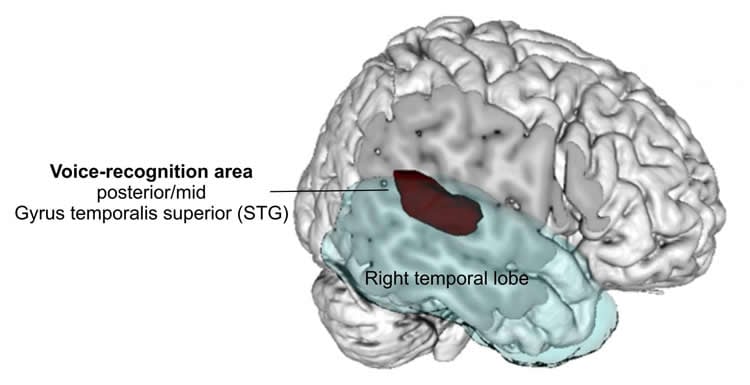Summary: A new study reveals the superior temporal gyrus appears to be critical for voice recognition.
Source: Max Planck Institute.
We regularly find ourselves in situations in which we talk to others. We talk to friends in a different way than we do to strangers. One important skill for this is not just understanding what the other person is saying but also recognising who is talking. Therefore, the voice of our conversation partner helps us. Until now, scientists could not agree on exactly which regions in the brain allow us to recognise voices.
“Very valid statements about which brain areas are responsible for which functions are derived from investigations in patients with lesions. If a certain part of the brain is injured and therefore a certain function fails, both components can be related to each other”, says Claudia Roswandowitz, scientist at the Max Planck Institute for Human Cognitive and Brain Sciences (MPI CBS) in Leipzig, and first author of a study which has revealed key findings about voice recognition. Roswandowitz, along with other researchers from the Research Group Neural Mechanisms of Human Communication, tested 58 patients with brain injuries and their capability to learn and recognise voices, especially those who had suffered a stroke. Additionally, the scientists looked at brain scans of the participants–high resolution images of their brain structures and injuries.
The neuroscientists found that especially persons with lesions in certain areas of the right posterior temporal lobe experienced difficulties recognizing voices. They assume that the posterior superior temporal gyrus, the STG, is crucial for voice recognition.

These findings were supported by a previous study at MPI CBS, whereby, a phenomenon commonly known as “voice blindness”, phonagnosia, the inability to recognize voices, was investigated. The two involved study participants–the only ones known in Germany to be affected by phonagnosia–were not able to identify people by voice, even their own mum or child. Roswandowitz and her colleagues also detected that changes in and to the right temporal lobe led to the corresponding deficits. In comparison to the other patients with lesions, the causes did not lie in the failed brain structures but rather in their different brain activity.
“These findings improve our understanding of how the brain identifies voices and provide the basis in the search for effective therapies for those affected by phonagnosia, a fairly common deficit which is sometimes present from birth but especially after a stroke. In our studies nine per cent of the participants reported suffering from difficulties in recognizing voices, a problem that is almost unheard of in the medical sector. Thus, we have to raise awareness of this matter”, says Roswandowitz.
Source: Verena Müller – Max Planck Institute
Publisher: Organized by NeuroscienceNews.com.
Image Source: NeuroscienceNews.com image is credited to MPI CBS.
Original Research: Full open access research for “Obligatory and facultative brain regions for voice-identity recognition” by Claudia Roswandowitz, Claudia Kappes, Hellmuth Obrig, and Katharina von Kriegstein in Brain. Published online December 8 2017 doi:10.1093/brain/awx313
[cbtabs][cbtab title=”MLA”]Max Planck Institute “Where Voice Recognition Occurs in the Brain.” NeuroscienceNews. NeuroscienceNews, 27 December 2017.
<https://neurosciencenews.com/neuroscience-voice-recognition-8233/>.[/cbtab][cbtab title=”APA”]Max Planck Institute (2017, December 27). Where Voice Recognition Occurs in the Brain. NeuroscienceNews. Retrieved December 27, 2017 from https://neurosciencenews.com/neuroscience-voice-recognition-8233/[/cbtab][cbtab title=”Chicago”]Max Planck Institute “Where Voice Recognition Occurs in the Brain.” https://neurosciencenews.com/neuroscience-voice-recognition-8233/ (accessed December 27, 2017).[/cbtab][/cbtabs]
Abstract
Obligatory and facultative brain regions for voice-identity recognition
Recognizing the identity of others by their voice is an important skill for social interactions. To date, it remains controversial which parts of the brain are critical structures for this skill. Based on neuroimaging findings, standard models of person-identity recognition suggest that the right temporal lobe is the hub for voice-identity recognition. Neuropsychological case studies, however, reported selective deficits of voice-identity recognition in patients predominantly with right inferior parietal lobe lesions. Here, our aim was to work towards resolving the discrepancy between neuroimaging studies and neuropsychological case studies to find out which brain structures are critical for voice-identity recognition in humans. We performed a voxel-based lesion-behaviour mapping study in a cohort of patients (n = 58) with unilateral focal brain lesions. The study included a comprehensive behavioural test battery on voice-identity recognition of newly learned (voice-name, voice-face association learning) and familiar voices (famous voice recognition) as well as visual (face-identity recognition) and acoustic control tests (vocal-pitch and vocal-timbre discrimination). The study also comprised clinically established tests (neuropsychological assessment, audiometry) and high-resolution structural brain images. The three key findings were: (i) a strong association between voice-identity recognition performance and right posterior/mid temporal and right inferior parietal lobe lesions; (ii) a selective association between right posterior/mid temporal lobe lesions and voice-identity recognition performance when face-identity recognition performance was factored out; and (iii) an association of right inferior parietal lobe lesions with tasks requiring the association between voices and faces but not voices and names. The results imply that the right posterior/mid temporal lobe is an obligatory structure for voice-identity recognition, while the inferior parietal lobe is only a facultative component of voice-identity recognition in situations where additional face-identity processing is required.
“Obligatory and facultative brain regions for voice-identity recognition” by Claudia Roswandowitz, Claudia Kappes, Hellmuth Obrig, and Katharina von Kriegstein in Brain. Published online December 8 2017 doi:10.1093/brain/awx313






